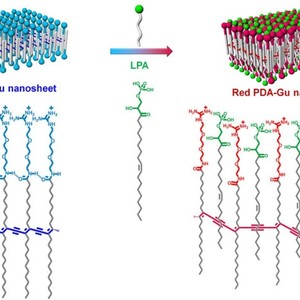An Ultrathin Polydiacetylene Nanosheet as Dual Colorimetric and Fluorescent Indicator for Lysophosphatidic Acid
Citation
Bojian Hu, and Peiyi Wu*. An Ultrathin Polydiacetylene Nanosheet as Dual Colorimetric and Fluorescent Indicator for Lysophosphatidic Acid, a Cancer Biomarker. Giant 2020, 3, 100025.
Abstract
Ultrathin two-dimensional (2D) nanosheets have been considered as one of the powerful platforms for chemical sensing of biomolecules. However, few 2D nanosheets with intrinsic chromatism exist for the specific and effective detection of some biomarkers. Here, we report a novel ultrathin chromic polydiacetylene (PDA) nanosheet via the self-assembly and photopolymerization of an amphiphilic guanidinium-capped diacetylene monomer (PCDA-Gu). The PDA-Gu nanosheets exhibit specific combination of lysophosphatidic acid (LPA), a biomarker for ovarian cancer, based on the synergistic salt-bridge interactions and hydrophobic interactions between the PDA-Gu nanosheets and LPA, and induced both color and fluorescence change. The linear correlation between the colorimetric response (CR) (or fluorescence intensity) and the concentration of LPA enable effective quantitative analysis of LPA in the biologically relevant low concentration range. Owing to their chromic properties and ultrathin lamellar structure, the PDA-Gu nanosheets have opportunity to act as a powerful indicator for LPA.


